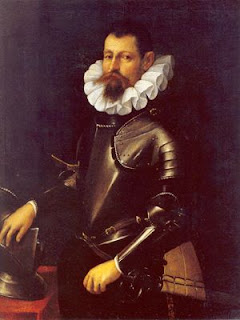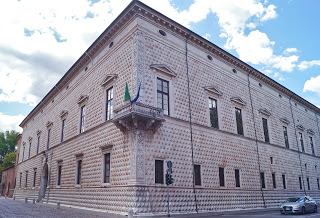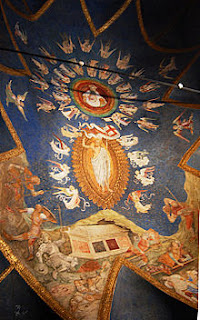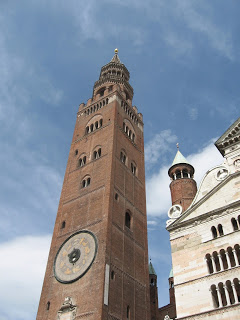Duchess was driven mad by husband’s infidelity
 |
| Virginia de' Medici married into the House of Este, gaining wealth and power |
She protected the autonomy of the city of Modena while her husband was away, despite plots against her, and she was considered to have been a clever and far-sighted ruler.
Virginia was the illegitimate daughter of Cosimo I de’ Medici, Grand Duke of Tuscany and his mistress, Camilla Martelli.
Her paternal grandparents were Giovanni dalle Bande Nere and his wife Maria Salviati, who was the granddaughter of Lorenzo the Magnificent. Her maternal grandparents were Antonio Martelli and Fiammetta Soderini, who were both members of important families in Florence.
In 1570, Cosimo I contracted a morganatic marriage with his mistress, Camilla, on the advice of Pope Pius V, which allowed him to legitimise his daughter.
Virginia lived with her parents at the Villa di Castello during the summer and in Pisa in the winter.
Cosimo I’s older children resented his second marriage and after his death in 1574 they imprisoned Camilla in a convent.
 |
| Cesare d'Este became Virginia's husband in an arranged marriage in 1586 |
The marriage did not take place because Sforza chose an ecclesiastical career and eventually became a Cardinal.
They then arranged a marriage for her with a member of the Este family and in 1586 Virginia married Cesare d’Este, the grandson of Alfonso I, Duke of Ferrara and son of Alfonso, Marquess of Montecchio.
A play was written and performed to celebrate this event in Florence and the poet, Torquato Tasso, who was living in Ferrara, dedicated a Cantata to the newly married couple.
When the couple arrived in Ferrara, they lived in the Palazzo dei Diamanti, which was given to them by Cardinal Luigi d’Este, Cesare’s uncle. A year later, Cesare’s father died and Virginia became Marchioness Consort of Montecchio after her husband inherited the title.
After Duke Alfonso II died in 1597 without issue, Cesare became the head of the House of Este and Virginia became Duchess Consort of Ferrara, Modena and Reggio and was given a wealth of other titles to do with territories owned by the Este family, some of which were in France.
Their rule over Ferrara did not last long as Pope Clement VII decided not to recognise Cesare’s succession. The Duchy of Ferrara was officially abolished and returned to the Papal States and Cesare and his family had to move to Modena. In 1601 he was also stripped of all his domains and titles in France.
 |
| The church of San Vincenzo in Modena, where Virginia is buried |
But she began to have unpredictable fits of anger and was thought to have been driven mad by knowing that her husband was often unfaithful to her. Her Jesuit confessor claimed she was possessed by the devil and tried to exorcise her demons.
It was later thought her mental illness was caused by having been married against her will and that it was worsened by her husband’s infidelity.
After Virginia’s death in 1615 in Modena at the age of 46 there were rumours that she had been poisoned by her husband but this was never proved. She was buried in the Este family crypt in the church of San Vincenzo in Modena.
 |
| The Palazzo dei Diamanti in Ferrara, which was a gift to Virginia and Cesare from Cesare's uncle, Cardinal Luigi d'Este |
Virginia and Cesare’s first home together was the Palazzo dei Diamanti in Ferrara. The palace, which is in Corso Ercole I d’Este, takes its name from the 8500 pointed diamond shaped stones that stud the façade, diamonds being an emblem of the Este family. It was designed by Biagio Rossetti and completed in 1503. The palace now houses the Pinacoteca Nazionale di Ferrara on its first floor, where you can also see the 16th century apartments inhabited by Virginia de’ Medici, three rooms that overlook Corso Biagio Rossetti. The art gallery is open from 10.00 to 17.30 Tuesday to Sunday.
 |
| The Palazzo dei Musei in Modena, which houses some of the Este inheritance Cesare and Virginia took to Modena |
Modena is a city on the south side of the Po Valley in the Emilia-Romagna region, known for its car industry and for producing balsamic vinegar. Operatic tenor Luciano Pavarotti and soprano Mirella Freni were both born in Modena. When Cesare and Virginia had to relocate from Ferrara to Modena, they tried to take with them as much of the Este inheritance as possible, including cases full of rare and precious objects. These now form part of the Este family collection on display in the Gallerie Estensi, on the upper floor of the Palazzo dei Musei in Largo Porta Sant’Agostino in Modena. The galleries are open to visitors from Tuesday to Sunday.
Also on this day:
1926: The birth in Florence of UK television personality Katie Boyle
1931: The execution of anarchist Michele Schirru
2013: The death of actress and writer Franca Rame
Home








